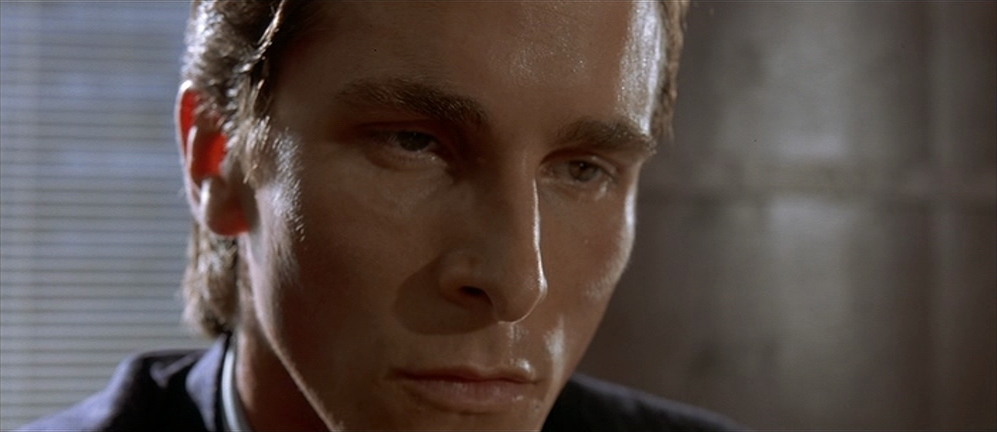American Psycho
 for strong violence, sexuality, drug use and language.
for strong violence, sexuality, drug use and language.
Reviewed by: Brett Willis
CONTRIBUTOR
| Moral Rating: | Extremely Offensive |
| Moviemaking Quality: |
|
| Primary Audience: | Adults |
| Genre: | Crime Drama |
| Length: | 1 hr. 41 min. |
| Year of Release: | 2000 |
| USA Release: |
April 14, 2000 |
| Featuring |
|---|
|
Christian Bale Willem Dafoe Jared Leto Reese Witherspoon Justin Theroux Josh Lucas Samantha Mathis Matt Ross |
| Director |
|
Mary Harron Andrzej Sekula |
| Producer |
| Christian Halsey Solomon, Ron Rotholz, Edward R. Pressman, Chris Hanley |
| Distributor |
“Monsters are real”
“American Psycho” marks a new low for major releases. Those who’ve read my other Spotlight reviews know I have a high tolerance for offensive material, and I try to give credit for artistic merit wherever possible. But I’ve walked out of a few films that I considered both offensive and pointless; and except for my intending to review it, this one certainly would have qualified.
The story centers on a young 1980s Wall Street hotshot, Patrick Bateman (Christian Bale), who inherited—rather than earned—his position in the company. In voiceovers, he details his meticulous diet, exercise and skin care regimens and other things that all focus on “self.” He and his coworkers, still in their daytime business suits, go to weird nightspots and snort cocaine. But although the whole group is hedonistic, he explains that he’s different from the others because he’s not really a part of humanity; everything he does is an act, and he has no emotions except greed and disgust (in other words, he’s Psychopathic/has a severe case of Antisocial Personality Disorder).
Bateman apparently admires the careers of serial killers such as Ed Gein and Ted Bundy.
Content warnings: There’s not much of a plot to give away, although a twist at the end might tempt some people to see the film a second time to unravel what they thought they’d seen. My purpose here is to persuade others NOT to see this film a FIRST time; so be prepared for enough detail to satisfy any curiosity you may have. Profanity is extreme, and there are many anti-female remarks and some racist ones. Bateman kills many victims, including prostitutes and homeless people, just for amusement (several killings graphically shown, others implied). He also develops (but can conceal) murderous rages against his coworkers over offenses such as someone else having the accounts he wants or having a better-looking business card. Besides his hands, feet and teeth, Bateman’s assault tools include knives, an axe, a nail gun, an automatic pistol, a coat hanger and a chainsaw. Bateman often excuses himself from a situation by saying he has to return some videotapes; the only tapes we glimpse him watching at home are slasher movies and porno films, and he apparently acts out what he watches. (As law enforcement people say: “Not everyone who watches this stuff is a pervert, but every pervert watches this stuff.”)
Bateman forces call girls to do things with each other as well as with him, and pays them extra for accepting violence (when he doesn’t kill them). There are simulated sex acts and glimpses of nudity in several scenes. These scenes are not sexy to me, but I don’t know how I’d feel if I were a teenager. Bateman keeps some of his victims’ bodies or body parts, and claims to eat the brains. The film seems off-balance, as though it had been re-edited (which it was, to overturn its initial NC-17 rating).
I saw this on a Saturday night and got to witness audience reaction. If all of the above weren’t bad enough, several scenes were played for laughs and did get laughs. In one such scene, Bateman starts to strangle a coworker who’s standing at a urinal, but the coworker happily takes this as a pass, and Bateman is so revolted by the idea of male homosexuality that he washes his hands and then runs away (thus the director, Mary Harron, links “homophobia” with Bateman’s other “problems”).
It turns out that there’s a second reason for the film’s off-balance feeling. It takes on an increasingly surreal tone, with Bateman performing impossible feats. Then we get clear evidence that Bateman is delusional (real ATMs don’t tell you to insert a stray cat) and that some or all of the murders never really occurred. In the end, we realize that everything we’ve seen was only Bateman’s version of reality. Most psycho-killer films (other than those marketed as episodes of an ongoing series) at least take the killer off the street and give some degree of closure. Not here. In fact, we don’t know if the killer really is a killer or just an elaborate fantasizer, and neither does he.
Canadian serial rapist/killer Paul Bernardo claims that his crimes were inspired by the novel on which this film is based. What might the film itself do? And the upcoming Summer 2000 films in the trailers consisted of sex comedies, over-the-top or comic-book style violence, and a Jim Carrey comedy about a cop with a violent split personality. Plus, the sequel to “Silence of the Lambs” (see my review of that film for some comments about Psychopathy) is due out later this year. With everyone from first-graders to senior citizens in retirement homes plotting or carrying out murders, I don’t see much of the “responsible voluntary restraint” that Hollywood’s been talking about. What are these studio execs thinking? I think it’s spelled with a dollar sign. I’ve already given them my ticket price for this abominable film; I hope that you save yours.
- Profane language: • J*sus (4) • Jeez • Chr*st (1) • G*d d*mn (2) • G*d (11) • H*ll (1)
- Vulgar/Crude language: • f-words (28+) • d*ck (4) • bl*w job (1), plus another reference to oral sex • sh-words (3) • a**hole (1) • a** (5) • b*tch (1) • b*stard (1) • Bimbo • slutty • Chicks • F*ggot
Learn about DISCERNMENT—wisdom in making personal entertainment decisions
 Every time you buy a movie ticket or buy or rent a video you are in effect casting a vote telling Hollywood, “I’ll pay for that. That’s what I want.” Read our article
Every time you buy a movie ticket or buy or rent a video you are in effect casting a vote telling Hollywood, “I’ll pay for that. That’s what I want.” Read our article


To her, the twin pinnacles of evil are capitalism and consumerism. And if there’s any doubt, the movie makes the point for us by tying Patrick Bateman’s heartless and depraved world to the man Harron wants to show us is responsible for it all—that trickle downer, boat-lifting tide riser, “Morning in America” phony, Ronald Reagan. This is nonsense, of course. Harron should put “The Scum Manifesto” back on her shelf and catch up with the times… AMERICAN PSYCHO contains nudity, graphic sex (often between three people), profanity and violence.
The violence is particularly disturbing because it is tied so closely to all forms of human interaction, especially to sex which is portrayed as a communal spectator sport (Patrick’s narcissism extends to watching himself in a mirror while he has sex with a woman), and a prelude to carnage. Harron even equates bloodshed with gourmet dining, a joke which begins with the film’s opening credits. She tries to draw a fine line between sensual indulgence and every other kind of indulgence, but she offers no retreat from these sins. And no redemption. [1/2]
For example, Bateman makes a reference to Ed Gein thus suggesting that people have two sides, a good side and an evil side. Fine, but Bateman seems to have the same personality throughout the entire movie. He is a little more over the top during the killing scenes, but not so much as to suggest a second personality… profanity is rough. Graphic cocaine use. But the worst is a threesome (unnecessary to the plot) that is graphically shown and sleazy in the way Bateman gives the two prostitute instructions. Another scene contain a porno movie playing loudly in the backround and is disgusting as well as distracting. Skip “American Psycho”. I wish I had. [1/2]
The film was cut to get an R rating and I’m scared of what they cut out, considering the trash that remains in this movie, in my opinion, is still enough to give it an NC-17. Besides containing explicit sex scenes, it was just downright boring and too slow. As I said, a couple of scenes I actually enjoyed, but would I pay to see this again? NO WAY! Actually, you couldn’t pay me to see it again. If I were you, I’d find something else worthy of your time and energy.







Patrick merely takes his agression out in a more destructive manner. In fact, all of these characters are so much alike, they even have trouble distinguishing one friend from another. Their situation has become a nameless and faceless society, all of which prompts Patrick to act out on these murderous impulses of that all of the characters have, to one degree or another. Another interesting feature of the film is, and this is going to sound funny, Patrick’s own morality.
He can’t help acting out these violent fantasies, but he doesn’t want to do them. He even tries to turn himself in, but no one believes him. Society forces him to be and to remain, a killer. And his own greed fuels that. He is a tragic-anti-hero. He tries to change what he is, but is unable to. Again, as for the content, there is a lot of violence, although considerably less than I thought there would be.
As for the menage-a-trois, it wasn’t supposed to be arousing, or even enjoyable. It was supposed to be disturbing and again show us the emptiness of the greed and power of Patrick’s life. And in the end, that is the statement that the film is ultimately trying to make—When you live your life for greed and power, and have no moral compass, ultimately you become exactly like Patrick. You may not take the lives of others, but there are different ways to kill people. My Ratings: [2/4]